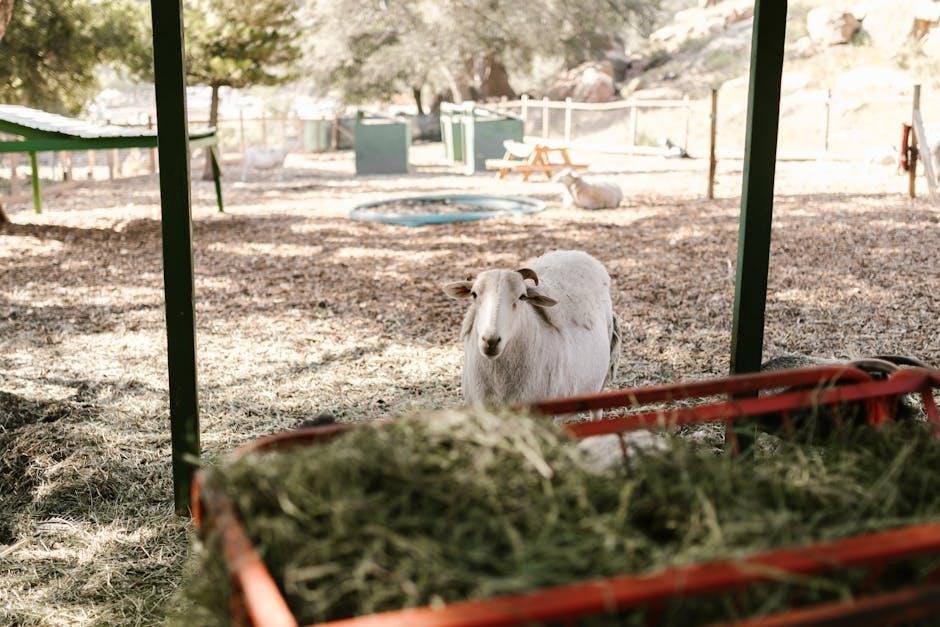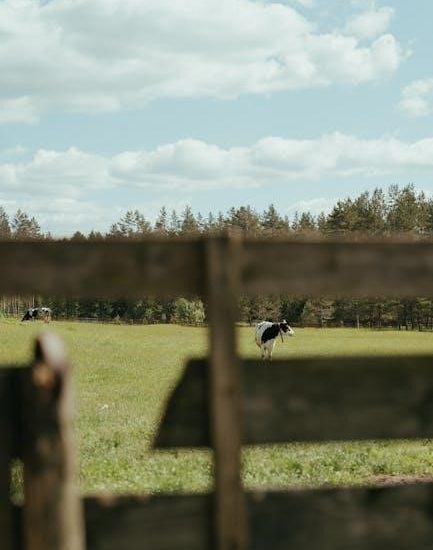Proper farm fence post spacing ensures durability‚ cost-effectiveness‚ and functionality. Factors like terrain‚ livestock type‚ and fence material influence spacing‚ which typically ranges from 8 to 30 feet apart‚ depending on the application.

Importance of Proper Post Spacing in Farm Fencing
Proper post spacing is crucial for ensuring the structural integrity‚ safety‚ and cost-effectiveness of a farm fence. Incorrect spacing can lead to weakened fence stability‚ making it vulnerable to damage from livestock‚ weather‚ or mechanical stress. Adequate spacing prevents sagging between posts‚ which can create gaps that animals might escape through or get injured by. Additionally‚ proper spacing ensures even distribution of tension in wire fences‚ reducing the risk of breakage and extending the fence’s lifespan. It also helps in minimizing maintenance costs by avoiding frequent repairs. Properly spaced posts contribute to the overall durability and functionality of the fence‚ making it a critical factor in effective farm management. By adhering to recommended spacing guidelines‚ farmers can create a secure and long-lasting enclosure for their livestock and crops.
Factors Affecting Fence Post Spacing
Factors affecting fence post spacing include terrain‚ livestock type‚ fence material‚ and local regulations. These elements ensure optimal post distance for a durable and effective fencing system.
Terrain and Land Conditions
Terrain and land conditions significantly influence fence post spacing. Flat or level ground typically allows for wider post intervals‚ often between 8 to 12 feet‚ while hilly‚ uneven‚ or rocky terrain may require closer spacing‚ such as 6 to 8 feet‚ to maintain structural integrity and prevent sagging. Areas with dense vegetation or curves may also need shorter intervals for stability. Additionally‚ soft or sandy soil might require deeper post holes to ensure stability‚ potentially affecting spacing. For example‚ in areas prone to erosion or with loose soil‚ posts should be placed closer together to prevent shifting. Conversely‚ firm ground can accommodate wider spacing. The natural landscape dictates post placement to ensure the fence remains secure and durable. Always assess the land carefully to determine the optimal spacing for your specific terrain conditions.

Type of Livestock and Their Impact on Fence Durability

The type of livestock significantly impacts fence durability and post spacing requirements. Larger animals‚ such as cattle‚ may require closer post intervals to prevent them from pushing through or damaging the fence. For instance‚ rowdy cattle might necessitate spacing of 4 to 6 meters to ensure the fence remains intact. Smaller animals like sheep or goats can be managed with slightly wider intervals‚ typically between 8 to 12 feet‚ but closer spacing may be needed to prevent them from slipping through gaps. Additionally‚ animals with aggressive behavior‚ such as bulls‚ may require reinforced fencing with shorter post intervals to withstand their strength. The weight and movement patterns of the livestock also play a role‚ as heavier animals can exert more force on the fence. Therefore‚ understanding the specific needs of your livestock is crucial for determining appropriate post spacing and ensuring the longevity of the fence. Proper planning helps prevent damage and keeps animals securely contained.
Material and Type of Fence
The material and type of fence significantly influence post spacing. For example‚ wooden fences typically require posts spaced 8 to 12 feet apart to ensure structural integrity and prevent sagging. Electric fences‚ on the other hand‚ can have wider spacing‚ often between 10 to 20 feet‚ as they rely more on the electrical charge than physical barriers. Barbed wire and high-tensile wire fences often use posts spaced 10 to 30 feet apart‚ depending on the wire’s strength and the terrain. Chain link fences‚ prioritize security and cost-effectiveness‚ with post spacing ranging from 4 to 10 feet. Vinyl fences‚ known for their durability‚ usually have posts spaced 8 to 12 feet apart. Woven wire fences‚ ideal for smaller animals‚ typically require closer spacing‚ around 8 to 10 feet‚ to prevent escape. The material’s weight‚ flexibility‚ and intended use dictate the optimal post spacing to ensure the fence’s stability and effectiveness. Proper spacing enhances the fence’s performance and longevity.
Local Regulations and Standards
Local regulations and standards play a crucial role in determining farm fence post spacing. Many areas have specific guidelines to ensure fences meet safety‚ structural‚ and legal requirements. For instance‚ zoning laws may dictate minimum or maximum post spacing to maintain property boundaries or prevent obstacles. Agricultural extension services often provide recommendations based on regional conditions‚ such as soil type or common livestock practices. Additionally‚ industry standards‚ like those from recognized fence manufacturers‚ can influence post spacing to ensure durability and effectiveness. Compliance with these regulations is essential to avoid legal issues and ensure the fence’s reliability. Property owners are encouraged to consult local authorities or fencing experts to adhere to all applicable codes and standards‚ ensuring their fence is both functional and compliant. Proper adherence to these guidelines helps maintain property value and neighborhood aesthetics while fulfilling practical purposes. Always verify local requirements before initiating fence construction to avoid costly adjustments later.

Standard Post Spacing for Different Fence Types
Standard post spacing varies by fence type‚ typically ranging from 8 to 30 feet apart. Wooden fences often use 8-12 feet‚ while high-tensile wire fences may span up to 30 feet between posts.
Wooden Fence Post Spacing
Wooden fence post spacing is a critical factor in ensuring the structural integrity and longevity of the fence. Typically‚ posts are spaced between 8 to 12 feet apart‚ depending on the fence type and purpose. For standard wooden fences‚ 8 to 10 feet is common‚ while heavier-duty applications may require closer spacing. The height of the posts also plays a role‚ as taller fences need more support to prevent sagging. Terrain and soil conditions can influence spacing‚ with uneven or rocky ground requiring more posts for stability. Additionally‚ the type of wood used affects durability‚ as harder woods like cedar or pressure-treated pine can withstand harsher conditions. Proper spacing ensures the fence remains secure‚ prevents warping‚ and withstands environmental stresses. It’s essential to align posts evenly and use sturdy materials to maintain a professional and durable finish. Consulting local fencing guidelines can also provide specific recommendations tailored to regional needs.
Electric Fence Post Spacing
Electric fence post spacing is determined by several factors‚ including terrain‚ livestock type‚ and fence voltage. Generally‚ posts are spaced between 20 to 50 feet apart‚ allowing adequate coverage without overloading the system. On flat terrain‚ wider spacing is feasible‚ while uneven or hilly landscapes may require closer posts to maintain consistent voltage. Livestock behavior also influences spacing; aggressive animals like cattle may need posts every 20-30 feet to prevent breakouts. Higher voltage fences often require wider spacing to avoid energy loss‚ but this must be balanced against the need for reliable animal containment. The type of wire or tape used also affects spacing‚ with thicker materials allowing for greater distances between posts. Regular inspections are crucial to ensure all components function correctly and safely. Proper spacing ensures effective animal control‚ reduces maintenance‚ and prolongs the fence’s lifespan. Always follow manufacturer guidelines for specific electric fencing systems to optimize performance and safety.
Barbed Wire Fence Post Spacing
Barbed wire fence post spacing typically ranges from 8 to 12 feet apart‚ depending on the specific application and terrain. Standard barbed wire fences often use posts spaced 10 to 12 feet apart‚ with three to five strands of wire. This spacing ensures adequate coverage and prevents excessive sagging between posts. However‚ for high-tensile barbed wire fences‚ posts can be spaced up to 20-30 feet apart due to the wire’s greater strength and resistance to sagging. The type of livestock being contained also influences spacing‚ as larger or more aggressive animals may require closer post intervals to prevent breakouts. Additionally‚ terrain plays a role; uneven or hilly landscapes may need closer spacing to maintain fence integrity. Proper construction and maintenance are critical to ensure the fence remains effective and durable over time. Always consider local regulations and standards when determining post spacing for barbed wire fences.
High-Tensile Wire Fence Post Spacing
High-tensile wire fences offer durability and flexibility‚ with post spacing typically ranging from 20 to 30 feet apart. This wider spacing is possible due to the wire’s high strength and resistance to sagging. The material’s elasticity allows it to absorb impact without breaking‚ making it ideal for large pastures and active livestock.Terrain and land conditions play a significant role in determining post spacing‚ with hilly or uneven areas requiring closer intervals to maintain structural integrity. For standard high-tensile wire‚ posts are often spaced 20-25 feet apart‚ but this can vary based on specific needs. Proper installation‚ including tensioning and bracing‚ is crucial to ensure the fence’s longevity and effectiveness. Additionally‚ local regulations should be considered to meet safety and agricultural standards. High-tensile wire fences are a cost-effective solution for farmers seeking a reliable and long-lasting enclosure system.
Chain Link Fence Post Spacing
Chain link fences are a popular choice for their durability and versatility‚ with post spacing typically ranging from 4 to 10 feet apart. This range ensures a balance between strength and cost-effectiveness. For security-focused installations or animal enclosures‚ narrower spacing (4-6 feet) is recommended to prevent breaches. Wider spacing (8-10 feet) is often used for general-purpose fencing‚ such as boundary demarcation. Terrain and intended use significantly influence spacing decisions‚ with uneven land requiring closer posts to maintain stability. Proper installation‚ including setting posts in concrete and tensioning the wire‚ is crucial for longevity. Regular maintenance‚ such as inspecting for sagging or damage‚ helps preserve the fence’s integrity. Chain link fencing is a practical solution for farms needing reliable‚ low-maintenance enclosures. Adhering to these guidelines ensures a sturdy and long-lasting fence that meets agricultural and security needs effectively. Proper post spacing is essential to maximize the fence’s performance and durability over time.
Vinyl Fence Post Spacing
Vinyl fencing offers a durable and aesthetically pleasing option for farm fencing‚ with post spacing typically ranging from 8 to 12 feet apart. This range ensures structural integrity while maintaining a clean appearance. The specific spacing depends on factors such as the height of the fence‚ local regulations‚ and the type of vinyl material used. Taller fences or those in high-wind areas may require closer post spacing (8-10 feet) to prevent sagging or damage. For shorter fences in stable conditions‚ wider spacing (10-12 feet) can be sufficient. Vinyl fence posts are usually set in concrete to ensure stability‚ and the material’s lightweight yet robust nature makes it suitable for various farm applications. Proper installation and adherence to manufacturer guidelines are crucial for maintaining the fence’s appearance and functionality over time. Vinyl fencing is a modern‚ low-maintenance choice that combines practicality with visual appeal‚ making it an excellent option for farms seeking a balance between durability and style.

Woven Wire Fence Post Spacing
Woven wire fencing is a popular choice for enclosing livestock due to its durability and effectiveness. The recommended post spacing for woven wire fences typically ranges from 8 to 12 feet apart‚ depending on the specific application and terrain. For standard woven wire fences‚ posts are often spaced 8 to 10 feet apart to ensure the fence remains taut and secure. In areas with uneven terrain or for heavier livestock‚ closer spacing (8-9 feet) is advised to prevent sagging and damage. For high-tensile woven wire fences‚ posts can be spaced up to 12-15 feet apart‚ as the material is stronger and less prone to stretching. Proper post spacing ensures the fence’s structural integrity and prevents gaps that livestock might exploit. Additionally‚ the gauge of the wire and the type of posts used will influence the optimal spacing. Regular maintenance and tight wire tension are crucial to maintaining the effectiveness of a woven wire fence over time.





